Construction Worker Electrocuted When Boom Forklift Contacted Power Lines
Iowa Case Report: 03IA055
Report Date: August 8, 2004
Summary
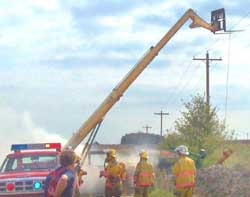 |
| Photo 1 – View of firefighters at the scene, showing the forklift near the power lines and the pump suspended by a wire rope cable. |
During the fall of 2003, a 53- year-old construction worker was electrocuted at a rural road construction site. A six man crew was on site that day, preparing to install a box culvert. The victim was working with a boom forklift operator to prepare a submersible pump for removing water from the work area. They had unloaded the pump from a pickup truck and had it suspended from the forklift with an 18 ft. (5.4 m) steel cable. The victim first untangled the hydraulic lines that were wrapped around the pump during transportation. The forklift operator was talking to him through the front window of the forklift, and asked if he was clear of the electric lines, and the victim gave him the thumbs-up sign. Suddenly, while they were talking, the forks came in contact with the overhead power lines, and the victim was electrocuted. As he was standing on the ground, hanging onto the two hydraulic lines, the electric current passed through the steel cable, the pump, and the steel mesh lining of the hydraulic lines to reach the victim and the ground. The man was killed instantly, and the hydraulic lines began arcing into dry grass and started a fire. This fire spread to the forklift and a portable power unit for the pump. The forklift operator initially stayed in his machine, then jumped free from the forklift as instructed in prior training, and was uninjured. When firefighters arrived, the victim was lying on the ground in the middle of the fire with the forklift near, but not touching, the power lines (see Photo 1).
Recommendations based on our investigation are as follows:
- Employers should comply with applicable OSHA regulations when using machines near energized power lines.
- Contractors who will be using lifting equipment near power lines should call the local power company to request that insulators or cover-ups be placed on the lines where they will be working.
- Site supervisors and machinery operators should consider safer alternatives and take extra precaution when working near overhead power lines
Introduction
During the fall of 2003, a 53-year-old male construction worker was electrocuted while working at a bridge construction site. The Iowa FACE program was notified of this incident the next day and began an investigation. Information was gathered from the county sheriff, the state medical examiner, newspapers, OSHA, the forklift manufacturer, and the construction company. Photographs were also acquired, and it was determined that a site visit was not necessary.
The employer is a heavy construction company operating in Iowa. The incident occurred at a site where the company was installing a new box culvert for a rural bridge project. This company had been in business for over 30 years, and had about 500 employees and multiple branch offices across the state, engaged in various types of heavy construction. The victim was a general laborer, one of six men working at the bridge construction site the day of the incident. He was an experienced worker, and was certified to operate forklifts and other heavy machinery.
The company had an extensive safety program with specific written procedures for various work tasks. They had operating instructions for machines, and procedures when working near power lines Safety meetings were held weekly, and many times on a daily basis, depending on the job at hand. Re-training of employees was required every three years and anytime a significant incident or work injury occurred. Machine-specific training was required of all employees, and all machine operators were required to receive certification from the company, manufacturers, or private consultants.
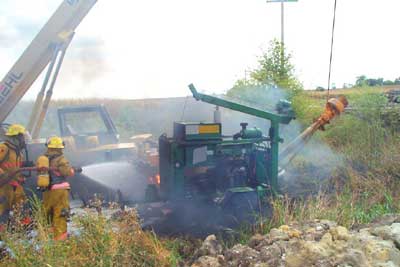 |
| Photo 2 – Second view of firefighters at the scene, showing the portable hydraulic power unit and the suspended. |
Investigation
The construction crew had been working on a rural road bridge project for a few days. They were in the preparation stage of installing a new box culvert. The victim was working with the operator of a rough terrain boom forklift, preparing a hydraulic submersible pump to drain a wet area where construction was to begin. Both men were certified forklift operators and had experience with these machines. The victim was standing in a grassy area between the forklift and a portable power unit for the hydraulic pump (see Photos 2, 3). Other workers at that location included the site superintendent, an excavator operator, and two other laborers.
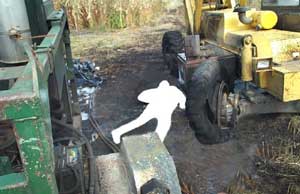 |
| Photo 3 – View between the forklift and the hydraulic power unit, facing north, showing position of the victim after he fell to the ground. |
The pump arrived on site in the back of a company pickup truck. It was an impeller pump, powered by two hydraulic lines, each approximately 20-25 ft. (6-7.5 m) long. The lines were wound around the pump, and the victim was unloading the pump and straightening out the lines.
The forklift was a Gehl model 883, about 8-10 years old. The machine had an 8000 lb. (3600 kg) capacity with a 40 ft. (12 m) maximum lift height. The boom was raised, lowered, extended, and contracted with a single control lever to the right of the operator’s seat (see Photo 4). The forklift was situated in a grassy area on the north side of overhead power lines The wires carried 12, 460 volts of three-phase power, and were 26 ft. 7 inches (8 m) from the ground at this location. The area to be drained was on the south side of these power lines After preparing the pump, the men were going to drive the forklift forward with the suspended pump and place it in the wet area south of the wires. A portable hydraulic power unit was already moved into position, sufficiently close to the wet area so that the hydraulic lines could be connected.
The victim and other workers on site initially agreed that they were clear of the overhead power lines The victim attached the 18 ft. (5.4 m) wire rope to the pump and slid the other end over one tine of the forklift. This length of cable was chosen because it was the normal method for placing pumps in wet areas. When using a long cable the workers do not have to go into the water and mud to disconnect the cable at the pump end, but rather disconnect at the fork end, leaving the cable attached to the pump for easier removal later. The pump was lifted out of the pickup truck, and the victim began to straighten out the hydraulic lines wrapped around the pump.
At this time, the forklift operator was communicating with the victim, most likely through the open front window of the cab. He asked if he had sufficient clearance from the power lines and the victim gave him the thumbs-up sign. Then suddenly the forklift came in contact with the northernmost power line, and the victim, who was standing on the ground, was instantly electrocuted. The victim was hanging onto the hydraulic lines with his right arm, and standing next to the hydraulic power unit, facing the operator when he was electrocuted (see Photo 3).
Although covered with rubber, hydraulic lines contain a stainless steel wire mesh sleeve which makes the line an excellent conductor of electricity. Current traveled through the forks, the 18-ft. cable, and the hydraulic lines to reach the victim and the ground. The victim dropped the hydraulic lines and fell forward to the ground, and the hydraulic lines began arcing into dry grass in the area and started a fire. The fire quickly spread to involve the forklift and the portable hydraulic power unit.
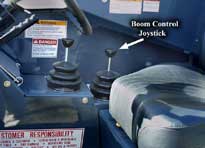 |
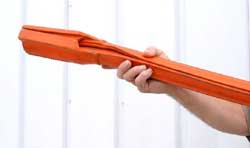 |
| Photo 4 – View of cab area of a new identical forklift, showing position of the joystick which controls the boom. | Photo 5 – Rubber sleeve (guts) used to insulate power lines |
The forklift operator witnessed the electrocution, then saw electricity jumping between the two hydraulic lines on the ground, fully aware of what had happened. He apparently backed off immediately from the wires, for the forks were not touching the wires when firefighters arrived. He remained in his seat to assess the situation, then jumped free and clear of the machine, according to prior safety training, and received no injuries.
The machine operator remains unclear as to exactly what happened, and assumes that something malfunctioned on the machine – that the forklift crept forward or the boom extension lever became stuck. Tests with the forklift after this incident, however, failed to reveal anything abnormal in its configuration or operation. The forks could have been raised or extended into the wires, or the machine could have been driven into the wires. From Photos 1 and 2, the pump is seen to the south of the grassy work area, with the hydraulic lines trailing in a straight line behind, suggesting it was being moved into position at the time of the electrocution.
According to Photo 1, the boom on this forklift was raised approximately 45 degrees, while the maximum angle was 74 degrees. The photo also shows the boom in a fully extended position. Photo 4 shows the right side of the operator’s area, which had three hydraulic controls: the front lever for the fork attachments, the middle 4-way lever for the boom itself, and the 2-way frame- leveling control to the rear. The middle control moved forward and backward to lower and raise the boom, and left and right to retract and extend the boom respectively.
If the operator was leaning far to his right, it might be possible to inadvertently push the middle lever to the right and extend the boom, but leaning to the right seems very unlikely due to the fixed window on the right side of the cab. This model of forklift had the front and left sides of the operator’s area completely open, while the right side window and rear window were permanently sealed. The top of the operator’s area was also open, with heavy cross members to protect from falling materials. The right window is always present and fixed as part of the safety requirements for this machine, protecting the operator from dangerous movements of the hydraulic components, which pass just a few inches from the window. Photographs confirm the presence of the right side window on this machine (see Photo 3), therefore, verbal communication between the workers had to be through other areas, most likely the front window area.
When this machine is at idle, the noise level is fairly low and it is easy for workers to verbally communicate. However at higher engine speed, the noise level is significantly higher, and verbal communication would be virtually impossible. During our tests on a new machine at engine idle speed, it was possible to slowly extend the boom without any appreciable increase in engine noise or obvious movements to workers on the ground.
The company in this case received citations from OSHA for failure to have a site specific program to identify electrical line hazards, for failure to designate a person to observe clearance from the power lines while the men were working near them with the forklift truck, and for failing to take precautions to de-energize the lines or install insulating barriers to power lines which could come within 10 feet of their equipment.
Cause of Death
The official cause of death was “high voltage electrocution”. Autopsy revealed multiple areas of electrical injury on the man’s right forearm and chest, indicating the current arced to his body in several locations simultaneously causing his death.
Recommendations/Discussion
Recommendation #1: Employers should comply with applicable OSHA regulations when using machines near energized power lines.
Discussion: OSHA Standards for the Construction Industry have specific requirements for using cranes, derricks, hoists, elevators, and conveyors (CFR 1926.550 Subpart N). The relevant requirements in this case included the following: (1) having a site specific program to identify electrical line hazards, (2) taking precautions to de-energize the lines or install insulating barriers, (3) using hand signals defined in ANSI standards, (4) keeping a minimum clearance of 10 feet between the lines (up to 50 kV) to any part of the crane, and (5) designating a person to observe clearance and to give timely warning where it is difficult to the operator to maintain clearance. The company was cited by OSHA for violating some of these regulations.
Useful precautions were taken to avoid hazards. Several workers confirmed that the men were clear of the power lines before they began to unload the pump in the grassy area. However, the victim, standing between the forklift and the power unit, was not in a good location to serve as a spotter. There were no designated spotters at the time of the incident, ensuring that safe distance from the power lines was maintained while they moved the pump into the wet area to be drained. The machine operator had communication with the victim, but the “thumbs-up” signal by the victim remains unclear and was not adequate. He may have meant to raise the load, extend the boom, to drive forward, or simply to proceed. Both men, having been certified to use boom forklifts, should have used proper hand signals described in ANSI standard to avoid miscommunication.
Recommendation #2: Contractors who will be using lifting equipment near power lines should call the local power company to request that insulators or cover-ups be placed on the lines where they will be working.
Discussion: Utility companies will apply insulators or cover-ups to power lines if construction companies will ask. These are five-foot long orange rubber sleeves (commonly called guts) that are joined end-to-end over the wires, designed to prevent electrical contact with machinery or men (see Photo 5). Locally, this is a free service, and utilities are happy to do this to avoid possible outage or serious injury in case of contact. When contractors encounter transformers and other complex overhead electrical arrays, utilities can also use rubber blankets or other special means to insulate their equipment. It is the responsibility of every contractor to determine ownership of power lines servicing and passing through areas where they are working. The use of insulating barriers is one listed requirement by OSHA, if equipment is expected to come within 10 feet of energized power lines [CFR 1926.550(a)(15)(i)].
Recommendation #3: Site supervisors and machinery operators should consider safer alternatives and take extra precaution when working near overhead power lines
Discussion: To comply with OSHA regulations, no part of the forklift should come within 10 feet of the energized overhead power lines At this site, the power line was about 26 feet from the ground and there was only 16 feet of safe vertical working space under the power lines. The 18 foot cable alone, even without the extra height from the forklift parts and the pump, made it impossible to safely operate under the power lines, using the long cable. The work crew could likely have considered several options. They may have been able to use a shorter cable or a chain to unload the pump and move it to the other side of the power lines. They could then have switched to the long cable for the final placement of the pump. They could also have unloaded the pump on the south side of the power lines, eliminating the need to work or travel under the wires.

|
Iowa FACE Program
FACE is an occupational fatality investigation and surveillance program of the National Institute for Occupational Safety and Health (NIOSH). In the state of Iowa, The University of Iowa, in conjunction with the Iowa Department of Public Health carries out the FACE program. The NIOSH head office in Morgantown, West Virginia, carries out an intramural FACE program and funds state based programs in Alaska, California, Iowa, Kentucky, Massachusetts, Michigan, Minnesota, Nebraska, New Jersey, New York, Oklahoma, Oregon, Washington, West Virginia, and Wisconsin.
The purpose of FACE is to identify all occupational fatalities in the participating states, conduct in depth investigations on specific types of fatalities, and make recommendations regarding prevention. NIOSH collects this information nationally and publishes reports and Alerts, which are disseminated widely to the involved industries. NIOSH FACE publications are available from the NIOSH Distribution Center (1-800-35NIOSH).
Iowa FACE publishes case reports, one page Warnings, and articles in trade journals. Most of this information is posted on our web site listed below. Copies of the reports and Warnings are available by contacting our offices in Iowa City, IA.
The Iowa FACE team consists of the following from the University of Iowa: Craig Zwerling, MD, PhD, MPH, Principal Investigator; Wayne Johnson, MD, Chief Investigator; John Lundell, MA, Coordinator; Risto Rautiainen, PhD, Co-Investigator, and John Kraemer, PA. from the Office of The State Medical Examiner.
To contact Iowa State FACE program personnel regarding State-based FACE reports, please use information listed on the Contact Sheet on the NIOSH FACE web site Please contact In-house FACE program personnel regarding In-house FACE reports and to gain assistance when State-FACE program personnel cannot be reached.

